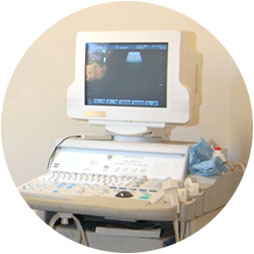alpine animal doctors veterinary services
ULTRASOUND

For more information or to make an appointment for this service please call...
5756 2444
- Monday: 8.30 to 5.30
- Tuesday 8.30 to 5.30
- Wednesday: 9 to 1
- Thursday: 8.30 to 5.30
- Friday: 8.30 to 5.30
- Saturday: 9 to 1
- Sunday: Closed
7047 Great Alpine Road,
Porepunkah, VIC 3740
Ultrasound at Alpine Animal Doctors
The use of ultrasound has become a fairly routine diagnostic tool in veterinary medicine. At Alpine Animal Doctors we use modern, highly efficient full doppler colour ultrasound devices and have both fixed and mobile ultrasound available.
Ultrasound scans, or sonograms, operate on the same principle as the sonar used on ships at sea and by mammals such as bats. High-frequency sound waves are reflected by the patient’s tissues and used to form images of tissues within the body, which are then recorded and displayed as a visual image on a computer screen. Because the images are being generated in real time, events such as blood flow, heartbeat and gastrointestinal movement can be observed as they occur.
Ultrasound is useful in far more conditions than its familiar role in pregnancy. Used together with digital radiology, baseline blood tests and urine analyses from our Pathology Lab, ultrasound provides an invaluable, safe, non-invasive diagnostic aid that is now a regular component of the thorough workups we provide for all of our patients.
We use abdominal ultrasound to examine organs including the liver, gall bladder, spleen, kidneys, bladder, prostate, uterus, ovaries, adrenal glands, stomach, and intestines. A properly conducted and accurately read ultrasound can help pinpoint the cause of many of the pet health issues we regularly come across, such as vomiting, abnormal urination and unexplained weight loss.
Ultrasound or echocardiograms have also revolutionised the early detection of heart disease and effective medical management of specific cardiac diseases.
Ultrasound is not some magic bullet, however. It can be very easy for an inexperienced operator to misinterpret an ultrasound image — for example, to mistake gas bubbles in the colon for bladder stones. It takes rigorous training and experience to master the skills needed to locate and examine the various organs and tissues and to be able to correctly identify any abnormalities.
An inadequate or incorrectly interpreted ultrasound can lead to misdiagnosis and possibly incorrect treatment, which can be very dangerous for your pet.
Ultrasound should be carefully and appropriately used, as part of an arsenal of diagnostic aids, including pathology, radiology and more specialised services such as endoscopy. At Alpine Animal Doctors we regularly use all of these techniques to help us discover and treat whatever condition your pets may be suffering from.
We have extensive training and years of experience in the generation and interpretation of sonograms and our clients can rest assured that when their pet needs an ultrasound they will receive professional treatment and an accurate diagnosis.

